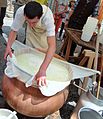cream cheese
Cream cheeses are types of cheese that, in contrast to other types of cheese, do not need to mature or only need very little aging and are consumed fresh. Cream cheeses are made from pasteurized milk that is thickened either through acidification alone or through a combination of an acid and rennet precipitation. The fat content is adjusted by adding cream. If herbs, fruits, etc. are added, it is a cream cheese preparation. The shelf life varies depending on the type: low-fat quark around three weeks and double cream cheese around three months. Cream cheeses have different consistencies: pasty (e.g. quark ), gel-like (e.g. layered cheese , mozzarella ) or grainy (e.g. cottage cheese ).
Manufacturing
For the production of fresh cheese (e.g. quark), lactic acid bacteria and usually a small amount of rennet or rennet substitutes are added to the heated milk. Now the curdling of the milk begins. By coagulating the casein, the so-called “jelly” (the “thickete”) is precipitated. First, the curd is cut with a cheese harp , which causes whey to leak ( syneresis ); the smaller the curd size, the more whey comes out and the stronger the cheese becomes. The syneresis and the whey leakage are promoted by heating the curd curds to 35–55 ° C. The whey drainage is increased by means of separators (for quark), cloths or sieves (for soft and hard cheese).
The skimmed quark obtained in this way is now enriched with cream in the desired fat content level, then passed through in order to obtain an even structure.
In contrast to quark , which hardly ripens at all, with cream cheeses, oidia and noble molds as well as yeasts cause a slightly sour nut kernel or mushroom taste.
To obtain grainy cream cheese, the curd is cut to the size of a grain of wheat, heated, washed and mixed with sweet cream and salt.
- Production of grainy goat cream cheese
Germany
In the German cheese regulation there is a separate cheese group for cream cheese . Cream cheese must have a water content in the fat-free cheese mixture of over 73 percent. That is why it can only be kept for a short time and must be stored as cool as possible. In contrast to other types of cheese, the preparation of cream cheese requires less rennet , a lower denaturation temperature and a longer denaturation time. Sometimes herbs and spices are added to it. It is available in all fat levels .
Cream cheese examples
- Brimsen
- Brousse du Rove
- Burrata
- Cottage cheese also grainy cream cheese, cottage cheese (made from skimmed milk but partly refined with cream)
- Mascarpone
- Panir
- Quark , also white cheese, Austrian curd cheese or Schotten
- Cream and double cream cheese
- ricotta
- Layer cheese
- Ziger
All variants have no rind and have a fresh, mild aroma. In addition to layer cheese and cottage cheese, cream cheese is characterized by a smooth and soft consistency. Since most of them are very soft, they are packed in plastic cups. The color varies from milk white to brown, depending on the fat content.
GDR
According to TGL 7947/02, cheese was systematized differently. Non-ripening cheeses were defined as a subgroup , which included cream cheese, layer cheese, buttermilk quark, quark and quark preparations.
Switzerland
In Switzerland there is also a separate group for cream cheese, here called " cheese type ".
literature
- E. Bames, Aloys Bömer, Adolf Juckenack, Joseph Tillmans: Tierische Lebensmittel , Springer Verlag Berlin Heidelberg GmbH, 1936, ISBN 978-3-662-41926-7 (eBook), p. 317
- Markus Fischer, Marcus A. Glomb: Moderne Lebensmittelchemie, Behr's Verlag, ISBN 978-3-89947-864-8 , p. 535
See also
Individual evidence
- ↑ a b Markus Fischer, Marcus A. Glomb: Modern Food Chemistry . Behr's Verlag, 2015, ISBN 978-3-89947-864-8 , pp. 535 .
- ↑ Kunz, Benno: Lexicon of food technology . Springer-Verlag, Berlin 1993, ISBN 3-540-56215-X , p. 94 .
- ↑ Erbersdobler, Helmut F., Nagursky, Jennifer .: Food product knowledge for beginners . 2nd Edition. Springer Berlin Heidelberg, Berlin, Heidelberg 2015, ISBN 978-3-662-46279-9 , pp. 36 .
- ↑ E. Barnes, Aloys Bomer, Adolf Juckenack, Joseph Tillmans: Animal foods . Springer Verlag Berlin Heidelberg GmbH, 1936, ISBN 3-662-41926-2 , p. 317 .





